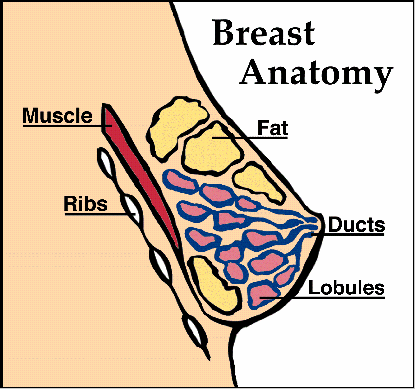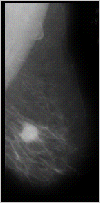

Cancer is a group of diseases, that occurs when cells become abnormal and divide without control or order. Every organ in the body is made up of various kinds of cells. Cells normally divide in an orderly way to produce more cells only when they are needed. Cancer begins as a single abnormal cell that begins to multiply out of control. Carcinoma of the breast occurs when a malignant change takes place in the cells that line the lobules that manufacture milk. Groups of such cells form tumors amd invade healthy tissue, often spreading to other parts of the body.
One of every nine American women will develop breast cancer sometime during her life(if she lives to the age of 85). This year, 185,000 women in the United States will be diagnosed with breast cancer and 46,000 will die of the disease. It is the most common form of cancer in women and the second leading cause of cancer death for women, after lung cancer.
The nipple is slightly below the centerpoint of the breast. Darker than the rest of the breast, its color varies from woman to woman. Like the entire breast, the nipple changes considerably during pregnancy and lactation, becoming larger and darker in color. The areola is the pigmented skin around the nipple. It has tiny bumps on its surface, some of which are sweat glands, others the endings of the Montgomery's glands, which lubricate the nipple for breast-feeding. A darkening of the areola is one of the earliest signs of pregnancy.
Acini are sacs lined with cells that can produce milk. The acini cluster together to form structures called lobules. The lobules empty into ducts that can carry milk to the nipple. The group of lobules that empty into any one duct is called a lobe. This milk producing system can be thought as a tree: the major ducts that end in the nipple constitute the trunk; as the ducts become finer, they resemble branches that spread throughout the breast, back form the nipple, and end in the lobules, which are like leaves of the tree. The breast is cushioned with fat that protects its important milk producing organs. It is mainly composed of fat. In small breasts there is little fat that on examination you feel mainly grandular tissue. As a woman ages, glandular tissue, no longer needed for infant feeding is replaced by fat.
Connective tissue called fascia that enclosed and support,a large supply of blood vessels-arteries, veins, and capillaries. The lymphatics, the veinlike vessels that drain the lymph into the bloodstream. A small number of lymph nodes that are found on the periphery of the breast and in the adjacent tissue of the axilla. Lymphatics are found throughout the body and serve to drain extracellular fluid from the tissue back into the blood stream. The lymphatic system, and particularly the lymph nodes, play an important role in the body's defenses and in its immune system. In the area of the breast, the lymphatics go from the breast and nipple to the nodes in the axilla and from there to the nodes above the clavicle. The central and inner part of the breast, however, can also drain to nodes under the breastbone.
Here is a glossary for terms that may be unfamiliar to you.

 All women are at risk. Approximately 70% of breast cancer occur in women with none of the currently identified "risk" factors such as family history, early menstruation, or late or no childbearing.
All women are at risk. Approximately 70% of breast cancer occur in women with none of the currently identified "risk" factors such as family history, early menstruation, or late or no childbearing.
 Breast cancer is the leading killer of American women ages 35-54.
Breast cancer is the leading killer of American women ages 35-54.
 Breast cancer is the most commonly diagnosed cancer in American women today--more common than lung and colon cancer.
Breast cancer is the most commonly diagnosed cancer in American women today--more common than lung and colon cancer.
 There are 1.8 million women in the U.S. who have been diagnosed with breast cancer. One million others have the disease and do not yet know it.
There are 1.8 million women in the U.S. who have been diagnosed with breast cancer. One million others have the disease and do not yet know it.
 The death rate from breast cancer has not been reduced in more than 50 years. One out of four women who are diagnosed with breast cancer die within the first five years--40% will be dead within ten years.
The death rate from breast cancer has not been reduced in more than 50 years. One out of four women who are diagnosed with breast cancer die within the first five years--40% will be dead within ten years.
 The incidence of breast cancer among American women has been rising for the past 30 years. And those who should know, don't know why.
The incidence of breast cancer among American women has been rising for the past 30 years. And those who should know, don't know why.
 Mammography fails to detect as much as 20% of all breast cancers, and recent studies show that it fails to detect as much as 40% of breast cancers in women under the age of 50.
Mammography fails to detect as much as 20% of all breast cancers, and recent studies show that it fails to detect as much as 40% of breast cancers in women under the age of 50.
 In just one year, the fatalities from breast cancer nearly equal the 58,000 Americans killed in the entire 12-year Vietnam War.
In just one year, the fatalities from breast cancer nearly equal the 58,000 Americans killed in the entire 12-year Vietnam War.
 182,000 women will be diagnosed with breast cancer this year--46,000 will die of the disease in the same period.
182,000 women will be diagnosed with breast cancer this year--46,000 will die of the disease in the same period.
 One out of every eight American women will develop breast cancer some time in her life. That rate has more than doubled in the past 30 years.
One out of every eight American women will develop breast cancer some time in her life. That rate has more than doubled in the past 30 years.
These facts are not meant depress but to inform you. There are however, a few personal stories that I found listed:
There are more than 100 different types of cancer, including several types of cancer. The most common type of breast cancer begins in the lining of the ducts and is called ductal carcinoma . Another type, called lobular carcinoma, arises in the lobules. When breast cancer spreads outside the breast, cancer cells are often found in the lymph nodes under the arm. If the cancer has reached these nodes, it may mean that cancer cells have spread to other parts of the body-other lymph nodes and other organs, such as bones, liver, or lungs. Cancer that spread is the same disease and has the same name as the original (primary) cancer. When breast cancer spreads, it is called metastatic breast cancer, even though the secondary tumor is in another organ.
The best chance for successful treatment occurs when cancer is found early. Mammograms, or special x-rays of the breast, can detect more than 90 percent of all cancers and should be part of every woman's breast health program, along with breast self exam and physical exam by the doctor. When breast cancer is found and treated early, a woman has more treatment choices and a good chance of complete recovery. So it is important to detect breast cancer as early as possible. The National Cancer Institute encourages women to take an active part in early detection. They should talk with their doctor about this disease, the symptoms to watch for, and an appropriate schedule of checkups. The doctor's advice will be based on the woman's age. medical history, and other factors.
 This is an actual mammography image of a breast with a lump.Mammography is an X-ray of the breast from the top and side view. The amount of radiation is very small. Mammography in younger women is less accurate. It usually reveals only dense breast tissue that may mask an underlying tumor. That is why doctors emphasize getting involved in your own early detection through monthly self breast examinations. Mammography is more accurate in women over the age of 50 whose grandular tissue has become atrophic and is replaced by fat. Mammography allows doctors to detect small and early changes that may be suspicious. It can detect breast cancer up to two years before your doctor can feel a lump.
This is an actual mammography image of a breast with a lump.Mammography is an X-ray of the breast from the top and side view. The amount of radiation is very small. Mammography in younger women is less accurate. It usually reveals only dense breast tissue that may mask an underlying tumor. That is why doctors emphasize getting involved in your own early detection through monthly self breast examinations. Mammography is more accurate in women over the age of 50 whose grandular tissue has become atrophic and is replaced by fat. Mammography allows doctors to detect small and early changes that may be suspicious. It can detect breast cancer up to two years before your doctor can feel a lump.
After reading some serious stuff maybe you would like to check out some light reading Ode to a Mammogram
Here is guide to breast lumps that may be helpful.
Treatment options include surgery, chemotherapy, and radiation therapy. However, a diagnosis of breast cancer does not mean a woman must lose her breast. When cancer is found early, breast conserving treatment of lumpectomy and radiotherapy is as effective as mastectomy for most patients.
Surgery is the most common. It may be used in combination with radiation treatments to assure adequate local treatment. Options include:
Breast-Conserving Surgery-which usually refers to as "lumpectomy". Only the the cancerous lump and a surrounding wedge of normal breast is removed, leaving most of the breast in place. Breast-conserving surgery is almost always followed by radiation treatments.
Simple Mastectomy-the entire breast is removed, but all of the lymph nodes and chest muscles are left in place.
Modified Radical Mastectomy-the entire breast and underarm lymph nodes are removed, along with the lining of the chest muscles, but muscles are left in place.
Radical Mastectomy-the entire breast and underarm lymph nodes, and chest muscles are removed. This procedure, though frequently performed in the past, is seldom, if ever used today.
Chemotherapy is the use of drugs to kills cancer cells. A combination of drugs is given by mouth or injection. It is given in cycles, with a treatment period followed by a recovery period, then another treatment. The side effects vary from person to person. Some common side effects are:
In radiation therapy, high-energy x-rays are used to damage cancer cells and stop them from growing. The therapy is usually conducted using external radiation, in which radioactive rays are directed to the breast by an x-ray machine. Rarely, internal radiation is used. Commonly, treatment is given five times a week for seven weeks. Some common side effects are:
Researchers believe that low fat-high fiber diet , along with an increase in fruits and vegetables and exercise can greatly reduce the risk of breast cancer. The key to the relationship between fat and cancer is estrogen. Dietary fat increases body weight, increasing the size of fat cells. Fat cells make estrogen which promotes breast cancer. So indirectly, more weight means more estrogen. Women who consume high levels of fat have, on average, higher levels of active estrogen. Getting on a low-fat diet reduces estrogen levels.
Studies have shown that stomach cancer and breast cancer are less common on high-fiber diets. Fiber affects levels of estrogen in the body. Estrogens are normally secreted into the the intestine, when fiber binds with the hormone and moves it out of the body. Without adequate fiber, the estrogen can be reabsorbed from the intestine into the bloodstream. High levels of estrogen are linked to a higher risk of breast cancer.
 The importance of fruits and vegetables is that they contain many cancer-fighting substances, in addition they are also low in fat and high in fiber. Cruciferous vegetables such as cabbage, broccoli, kale, turnips, cauliflower and Brussels sprouts contain flavones and indoles which are thought to have anti-cancer activities. Vitamin C, found in fruits and vegetables, may lower risks for cancer of the esophagus and stomach. Vitamin C acts as an antioxidant, neutralizing cancer-causing chemical that form in the body. It also blocks the conversion of nitrates to cancer-causing nitrosamines in the stomach. Selenium is found in whole grain and has the same antioxidant effects as vitamin C and beta-carotene.
The importance of fruits and vegetables is that they contain many cancer-fighting substances, in addition they are also low in fat and high in fiber. Cruciferous vegetables such as cabbage, broccoli, kale, turnips, cauliflower and Brussels sprouts contain flavones and indoles which are thought to have anti-cancer activities. Vitamin C, found in fruits and vegetables, may lower risks for cancer of the esophagus and stomach. Vitamin C acts as an antioxidant, neutralizing cancer-causing chemical that form in the body. It also blocks the conversion of nitrates to cancer-causing nitrosamines in the stomach. Selenium is found in whole grain and has the same antioxidant effects as vitamin C and beta-carotene.
All the evidence points to a low-fat, high-fiber diet , that includes a variety of fruits, vegetables, whole grains, and beans, as being the best for cancer prevention. It seems that vegetarians meet these requirements and are the lowest rick for cancer. They tend to eat more soy products than meat eaters. Soybeans contain many substances that are anticarcinogens. For more information on vegetarians.
It may be difficult to change your diet so drastically. So to make the transition a little easier here is a list of links to recipes:

Visit the American Cancer Society
Visit the American Cancer Society Breast Cancer Network
Visit the Susan G. Komen Breast Cancer Foundation
Visit the National Breast Cancer Centre Home Page
Visit the Breast Cancer Information Clearinghouse

Women's Cancer Groups in US and Canada
Y-Me National Breast Cancer Organization
Women to Walk Against Breast Cancer
Breast Cancer Information Clearinghouse
National Alliance of Breast Cancer Organizations
Here is a glossary for terms that may be unfamiliar to you.
This page was created by
 Melissa Bautista.
Melissa Bautista.
The following has been added by the Electronic Desktop Project:
 Contact Us
Contact UsIf you are an educator who is using our NEXTSTEP or virtual applications in the classroom, we would especially like to hear from you. Let us know what you are doing and how it is working out. Continued support for this project will depend on its impact in science education.
If you are an educator who is interested in making use of our NEXTSTEP or virtual applications, please let us know how we can help.
 Return to the Electronic Desktop Project home page
Return to the Electronic Desktop Project home page
![]() Check out the WWW Virtual Application Catalog from the EDP
Check out the WWW Virtual Application Catalog from the EDP
 Check out the NEXTSTEP Application Catalog from the EDP
Check out the NEXTSTEP Application Catalog from the EDP
 Visit the home page for California State University, Los Angeles
Visit the home page for California State University, Los Angeles